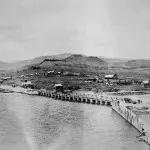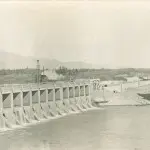The first dam on Jackson Lake was built in 1906; it was intended for temporary purposes and built with temporary materials. The area around the outlet of Jackson Lake was not suitable for human habitation as high spring runoff from the mountains made much of the bottom lands too wet for building and susceptible to seasonal flooding. While the first dam helped somewhat, staving off the worst of the spring floods, it failed just four years later. Constructed of log rip-rap with dirt infill, it was in need of constant maintenance and would only raise the water of the lake by a few feet. It was deemed necessary to remove the damaged materials and rebuild a permanent structure.
In 1902, the Reclamation Act was signed by President Theodore Roosevelt to encourage further settlement of the arid west. The federal government would take on several projects meant to facilitate the flow of water to create better resources for agriculture. Dams, irrigation ditches, canals and reservoirs were built throughout the west. The idea was to create the necessary infrastructure to provide water for ranchers who were struggling on their 160 acre plots that were not suitable for anything but grazing. The government would provide the expertise and complete the construction, while the homesteaders would pay back the costs within ten years.
At Jackson Lake, the Reclamation Service built the dam with the intention of controlling lake levels for irrigation on farmlands on the Snake River in Idaho. With a growing population, Moran became an ideal site for locals to set up businesses that would cater to the dam workers. Benjamin Sheffield was one of the first to settle the town site, purchasing two homesteads outside the outlet of Jackson Lake in 1903. Sheffield saw the area as a prime location to set up a lodge as a base from which to lead hunting expeditions. His foresight was rewarded when the Reclamation Service decided to build a dam on Jackson Lake in 1906. This meant that the spring runoff would cease to flood his property and he could construct more cabins. It also allowed Sheffield to construct a toll bridge over the now predictable water. This bridge was one of just three crossings over the dangerous, twisting river that bisected the valley. The others were located at Menor’s Ferry and at the Jackson-Wilson Bridge in Wilson.
The Reclamation Service built their own camp that housed and fed the dam workers, and even included a hospital. They would later rebuild the Marysville road as the new Ashton-Moran Road in 1910 to bring in supplies for the construction. Frank T. Crowe was the project supervisor, and ordered over 300,000 tons of equipment to service the construction project. The Ashton-Moran Road, which still exists today, continued to be a popular route to transport supplies into the valley after the dam was finished. The Reclamation Service dominated the population of Moran, and the area became known as a “military town.”
Construction on the new dam began in 1911, and continued until 1916. By this time the town had a stable economy due the amount of visitors traveling to and from Yellowstone National Park. The 1916 dam still exists today, having been reinforced in 1986-89 in order to meet new requirements for earthquakes.
Text by Samantha Ford, Director of Historical Research and Outreach


